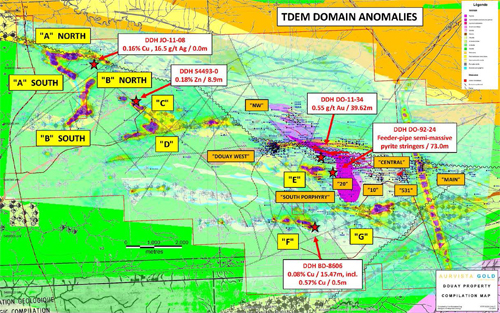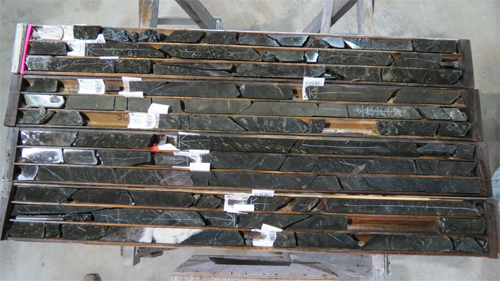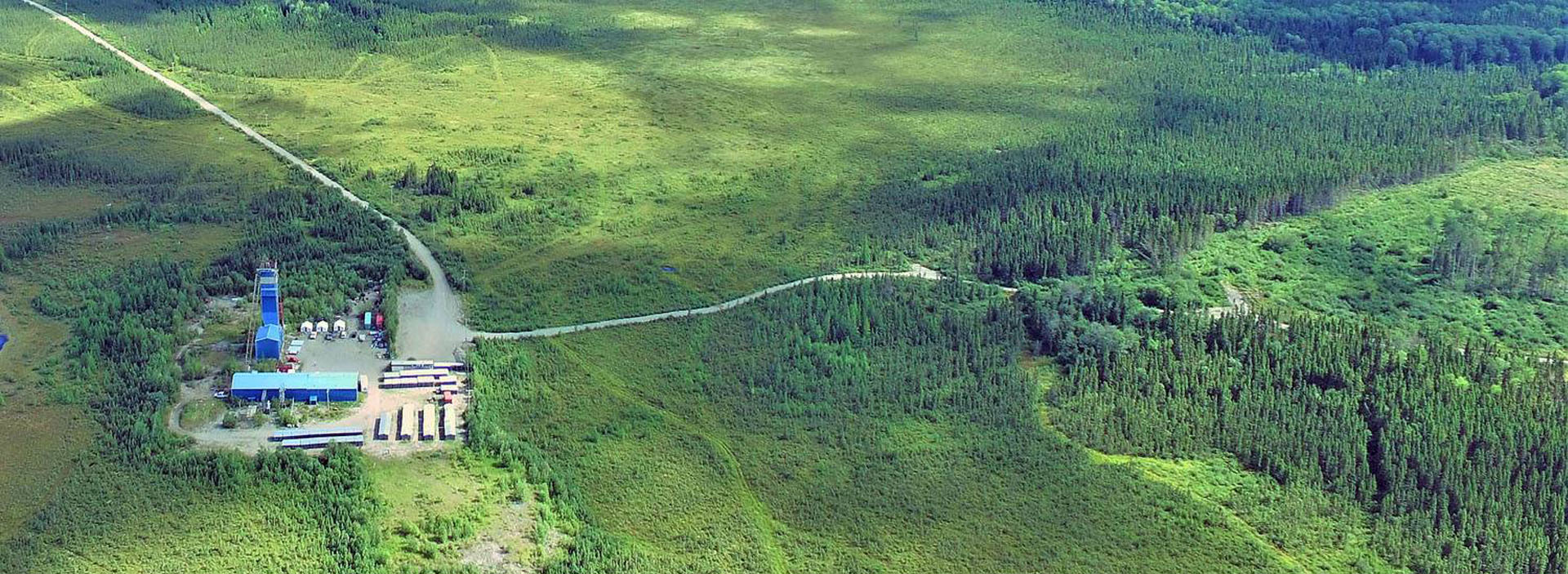- Geophysical-geological interpretation defines a primary Copper-Zinc massive sulphide signature
- Overprinted by a secondary Gold enrichment associated with multiple structural events linked to the Casa Berardi Deformation Zone
- Gold zones form part of multiple, subparallel, E-W trending faults, individually extending more than 4 km in length
Montreal, Quebec: Aurvista Gold Corporation (“Aurvista” or the “Company”) (TSX-V: AVA, OTC: ARVSF; Frankfurt: AV2) announces the completion of an Airborne Magnetic-Time Domain Electromagnetic-Radiometric Geophysical Survey (the “Survey”) (refer to the Company news release dated June 14, 2016) and the release of Survey’s result, in addition to an update of the Company’s on-going Detailed Targeting Program at its 100% owned Douay Gold Project (“Douay“) with drilling planned for Q4-2016 and Q1-2017.
Geophysics focused on Douay’s central and western portions and was primarily designed to define key contacts and faults which could be linked to the gold mineralization, their extensions and outline potential gold-bearing massive sulphides within 2 km of the porphyry unit, all to a depth of -150 meters, within the 10 km long by 3 km wide Douay-Style Mineralization (“DSM”) corridor. Previous geophysical programs identified a number of EM-INPUTTM anomalies that are consistent with massive sulphide development as discovered elsewhere in Quebec-Ontario segments of the Abitibi Belt.
2014-2015 Geophysical Compilation and Interpretation
In 2014, Aurvista completed a Geophysical Interpretation (the “GI”) of the 1976 government electromagnetic-magnetic (“EM”) INPUTTM survey, the 11 ground Induced Polarization (“IP”) surveys completed from 1986 to 2011, and the Company’s 2011 airborne magnetic and the 2 ground IP surveys from 2015 (refer to previous Company news releases dated December 17, 2014, and April 8 and April 30, 2015). The GI assisted in identifying additional targets with similar geophysical signatures to those associated with already known gold mineralization on Douay.
The interpretation confirmed the DSM corridor comprising of a SE-tilted parallelogram-shaped block, bounded in all directions by SE-NW and NE-SW splay faults of the E-W trending Casa Berardi Deformation Zone (the “CBDZ”). The DSM consists of a unique geophysical response of chaotic, non-linear, and distorted bands of strong magnetic highs and complementary lows resulting from the faulting, shearing, and alteration of the host rocks. The 8 known higher and 2 lower grade gold zones within the DSM occupy magnetic lows and are surrounded by strongly magnetic basalts and gabbros. The GI also showed potential outside the DSM for additional significant and untested gold and base metal mineralization along the 20 km trend of Douay. EM INPUTTM clusters of conductors were identified and require further testing to confirm potential massive sulphides based on the geological-geophysical association.
IP can help identify disseminated sulphides and faults potentially linked to the gold and/or VMS mineralization. The IP at Douay showed a complex array of crisscrossing E-W, NW-SE and NE-SW faults mirroring structures outlined by the airborne magnetic survey. The array forms anastomosing patterns, and as in the case of the heavily tested Douay West Zone, the gold mineralization appears to sit at the junction of anastomosing faults. Where narrower linear IP resistivity lows occur they are overlapped by similar linear EM-INPUTTM anomalies, and correspond to conductive linear and recessive graphitic faults typical of the CBDZ. Discrete groupings of EM INPUTTM anomalies located in felsic and mafic volcanic rocks are associated with areas of higher IP resistivity, likely a non-graphite component to the conductors, such as sulphide-bearing cherts, as observed within the 6 km by 1 km EM INPUTTM grouping running westwards from the South Porphyry.
2016 Geophysical Survey and Interpretation
Aurvista contracted Prospectair Geosurveys of Gatineau (Quebec) to complete and airborne helicopter magnetic, time-domain electromagnetic (“TDEM”) and radiometric survey to complement the 1976 EM-INPUTTM and 2011 magnetic survey but at greater depth. A total of 1,421 line-km were flown along N-S 150 m spaced lines with the magnetic responses mimicking those from the Aurvista 2011 magnetic survey. The Total Counts per Second (“CPS”) of the radiometric portion of the Survey maps out 3 areas of shallow overburden (higher CPS) with felsic rocks either “granites”, porphyries, cherts and/or rhyolites-rhyodacites (“1” to “3”), 8 linear troughs (lower CPS) linked to possible faults (“4” to “11”), and the N-S esker (higher CPS) (“12”) under the Amos-Matagami provincial highway (higher CPS).
The TDEM survey outlined 7 strong anomalies (“A” to “G”), all associated to the strongest EM-INPUTTM anomalies, 4 in proximity to the CBDZ (“A” to “D”), NW of the DSM, and 3 in proximity to, and surrounding the ‘South Porphyry” (“E” to “G”), S of the DSM (refer to Figure 1 using the following link). Characteristics of each anomaly is summarized in the following table:
|
TDEM ANOMALY |
LOCATION |
LENGTH x WIDTH |
AZ. | COMMENTS |
| “A” NORTH |
CBDZ, NW corner of the Douay Property |
1,300m x 150-250m peak | 106° | 3,500m long anomaly; DDH JO-11-08: 0.16% Copper, 16.5 g/t Silver / 0.9 m in sulphide cherts |
| “A” SOUTH | 1,300m x 220m | 130° | None | |
| “B” NORTH |
500m SE of “A” |
800m x 220m | 215° | None |
| “B” SOUTH | 1,100m x 150-450m | 225° | Left-handed offset of “B” NORTH | |
| “C” WEST “C” EAST |
1,200m E of “B” | 950m x 100m | 115° | Two peak conductors separated by magnetic, non-conductive NE diabase-gabbro dyke; DDH54493-0 from “C”: 0.18% Zinc / 8.9 m |
| D | Ties onto “C” to the SE | 4,000m X 200-700m | 090° | 3 peaks conductors; largest 450m x 300m; marker horizon(?) between felsics (higher CPS)-mafics (lower CPS) with (?)massive sulphide connection |
| E | 6km x 1km Cluster EM -INPUTTM anomalies, 750m due S of “Adam-Porphyry”, Due W of “South Porphyry, bounded to he E by the “20” Zone | 950m x 100m | 125°, 090° | 450m x 200m middle offshoot trending E-W; DDH DO-92-24 (“20” Zone), 300m E with semi-massive pyrite stringers in chlorite “feeder-pipes” / 73m (77m to 150m) plus altered basalt / 39.62m (41.15m to 80.77m) with 0.55 g/t gold; DDH DO-11-34, 500m N of cluster, 300m NW of DO-92-24, with pyrite stringers in chlorite “feeder-pipes” / 55.5m (28.5m to 84m) |
| F | 1,700m due S of “E” | 1,500m x 200-250m | 100° | 3 conductive peaks from small to large; peak conductor drilled (1987) with 9 holes, intersected black argillites in basalts: 0.08% Copper / 15.47m from 57.20m to 72.67m, including 0.57% Copper / 0.5m from 57.20m to 57.70m (DDH BD-8106) |
| G | 300m due S of “South Porphyry” | 2,600m x 500m | 150° | Contiguous to, parallel to DSM |
To summarize, Anomaly “E” is the most significant, located in proximity to the gold bearing “Main Porphyry”, the “South Porphyry” and the “Adam-Porphyry”. There are chlorite-sulphide bearing “feeder pipes” nearby as observed in drill holes DO-92-24 (refer to Figure 2 using the following link) and DO-11-34, typically found in association with massive sulphide mineralization, yet to be found at Douay. The historical drill holes DY-99-04, 05 and 06, 46878-0, 46899-9 and 0, 64487-0, 468880-0 and D-92-32 skimmed the anomaly by drilling above or holes were too short, but explained the conductive source as graphite. There is no graphite in the re-logged drill core.
Aurvista is committed to the continued exploration of Douay
The Company is well advanced in its previously announced 2016 two-staged exploration campaign on Douay with the primary objective of defining drill targets to increase known Mineral Resource estimates*.
The First Stage of the campaign, slated for completion in Q4-2016, will tackle Priority Targeting (the "Program") in two areas, the DSM and 6km by 1 km EM-INPUTTM sector, where management is confident additional gold mineralization will be discovered. The Second Stage will consist of 4,000 metres of drilling to delineate additional gold mineralization.
The Aurvista exploration team is now focused on core re-logging of previous and historic drill holes along 26 sections across Douay, including all previously known gold mineralized and non-mineralized segments, with the purpose of defining the chemical signatures and alteration mineralogy of the known gold mineralization. The purpose of this work is to confirm the suspected source of the volcanic intrusion. This work integrated with the geophysics will assist in vectoring the drills towards additional gold mineralization and the drilling of the best priority targets that could potentially lead to a better quality and expanded mineral resource. To date, drill core re-logging of 45,000 meters of the nearly 200,000 meters of drill core of site stored from all previous vendors is presenting a much simpler geological picture than previously interpreted.
There are two distinct but overlapping geological signatures: a primary Volcanogenic Massive Sulphide (“VMS”) of Copper-Zinc affinities overprinted by a secondary structurally hosted gold system. The interpreted geological signature is very similar to the 15+ million ounce Doyon-Bousquet-Laronde Mining Camp located 100 km S-SW of Douay, along the Cadillac Larder Lake Deformation Zone.
Douay now consists of a northern corridor of fairly pristine, well preserved volcanic tuffs of felsic to intermediate compositions; the central 3 km wide DSM corridor hosting the CBDZ with a mix of porphyries, basalts, felsic volcanic rocks and iron formations, and gold-hosted shear zones; and a southern corridor of mostly basalts with siliceous-chemical sediments and chlorite-sulphide bearing feeder-pipes, both typical of VMS systems.
There are well defined continuity of geological units and structures across Douay as was suggested by the previous 2014-2015 geophysical interpretation which has now been confirmed as the iron rich host of the “Douay West” Zone, west of the “South Porphyry”, was also observed E-SE of the same porphyry for a distance of 4+ km. The E-W fault or shear zone hosting “Douay West” is the same structure hosting the “Adam-Porphyry”.
The volcanic stratigraphy trends in a NW-W to E-SE directions whereas the gold structures trend E-W. There are at least a dozen of these subparallel structures. The previously held interpretation of 8 independent higher grade gold zones is incorrect. Management believes there are additional higher grade zones and are linked by an extensive network of E-W, NW-SE and NE-SW structures in magnetic iron rich volcanic rocks, but now non-magnetic sulphide bearing, hosting iron-carbonates alteration, porphyries and/or silica-rich alteration and/or sodium-rich alteration.
The technical contents in this news release have approved by Mr. Jean Lafleur, M. Sc., P. Geo., President and CEO for Aurvista Gold Corporation, and Mr. Yvan Bussières, P. Eng., the Douay Project Manager. Both individuals are Qualified Persons under National Instrument 43-101.
About Aurvista Gold Corp.
Aurvista Gold Corporation is a junior gold exploration and development Company with 90,689,121 shares outstanding trading on the TSX Venture Exchange in Canada, the Frankfurt Stock Exchange and OTC Pink Sheets in the US. Aurvista’s only asset is the Douay Gold Project, consisting of a 100% owned interest in 250 contiguous claims totaling 133.1 km2, plus a 90% interest in 5 contiguous claims totaling 0.2 km2 and a 75% interest (25% held by SOQUEM) in 32 contiguous claims totaling 11.9 km2. In total there are 287 claims covering 145.3 km2 located along a 20 km segment of the Casa Berardi Deformation Zone in the prolific Abitibi Belt of northern Quebec. Douay is located 40 km SW of the Matagami Zinc Base Metal Camp and 150 km N of the Val-d’Or-Malartic Gold Camp (both in Quebec).
In August, 2012, Aurvista updated the Mineral Resources estimates* that included all drilling completed to the end of March 2012. Douay contains Mineral Resources estimates* of 2.7 million tonnes of Indicated Resources at 2.76 g/t gold for 238,000 ounces (above a 0.3 g/t gold cut-off grade) or 3,458,000 tonnes grading 2.98 g/t gold (at a 0.5 g/t gold cut-off grade) for 235,500 ounces. There were additional Inferred Resources of 115 million tonnes at 0.75 g/t gold for 2.75 million ounces (above a 0.3 g/t gold cut-off grade) or 62 million tonnes grading 1.06 g/t gold for 2.1 million ounces (above a 0.5 g/t cut-off grade). Details can be viewed on the Company’s website at www.aurvistagold.com.
For further information please contact:
| Mr. Jean Lafleur, P. Geo. President and CEO, Director Cell: +1 514 927 3633 |
Mr. Bryan Keeler Chief Financial Officer +1 416 504 4126 |
NEITHER THE TSX VENTURE EXCHANGE NOR ITS REGULATION SERVICES PROVIDER (AS THAT TERM IS DEFINED IN THE POLICIES OF THE TSX VENTURE EXCHANGE) ACCEPTS RESPONSIBILITY FOR THE ADEQUACY OR ACCURACY OF THIS PRESS RELEASE.
Forward-Looking Statements
This news release may contain forward-looking statements based on assumptions, uncertainties and management’s best estimate of future events. Actual events or results could differ materially from the Company’s expectations and projections. Investors are cautioned that forward-looking statements involve risks and uncertainties. Accordingly, readers should not place undue reliance on forward-looking statements. When used herein, words such as “anticipate”, “will”, “intend” and similar expressions are intended to identify forward-looking statements. For a more detailed discussion of such risks and other factors that could cause actual results to differ materially from those expressed or implied by such forward-looking statements, refer to Aurvista Gold Corporation’s filings with Canadian securities regulators available on www.sedar.com or the Company’s website at www.aurvistagold.com.
Figure 1. Douay Gold Project Location Map with Bedrock TDEM Conductors, Geology and EM-INPUTTM anomalies.
Figure 2. Chlorite bearing “feeder pipes” in DDH DO-92-24 yielding 18 meters of semi-massive pyrite stringers. NQ core with end of hole towards the lower right corner. Core box length is 1.5 meters.

